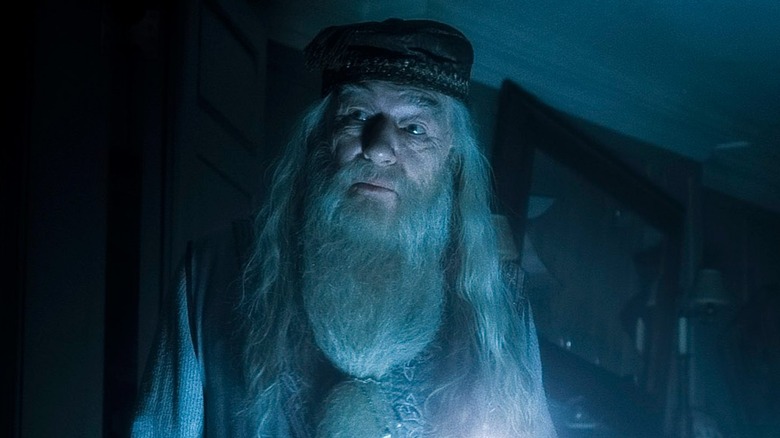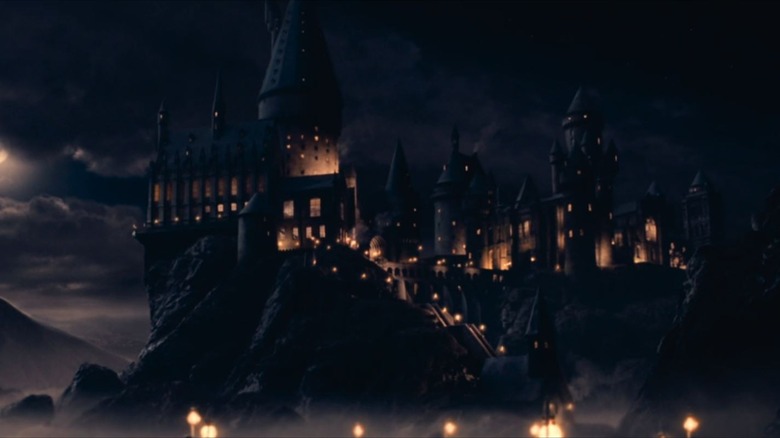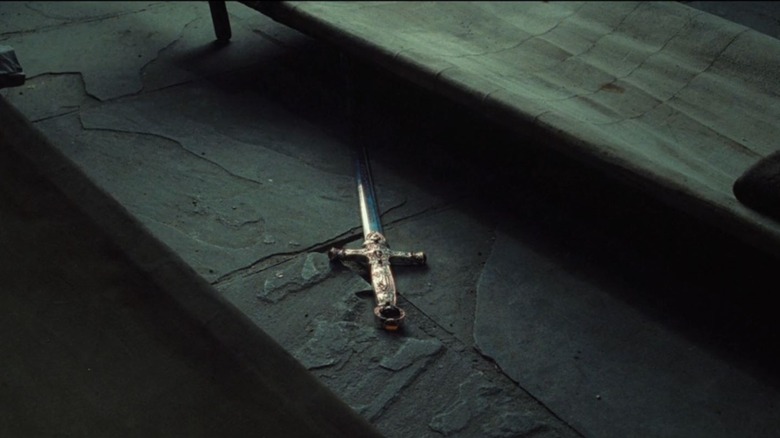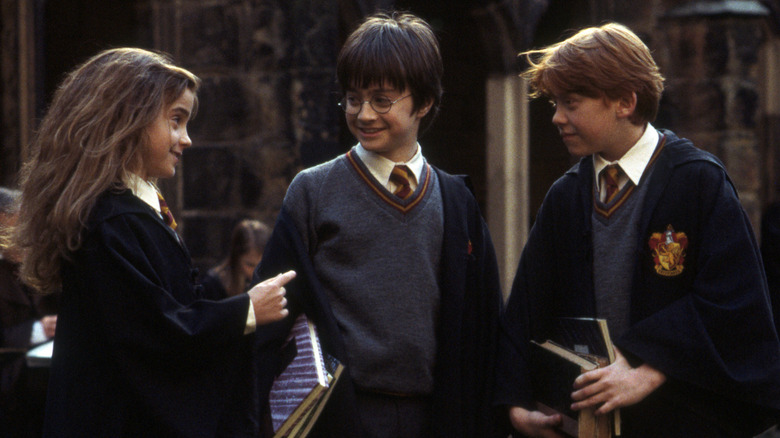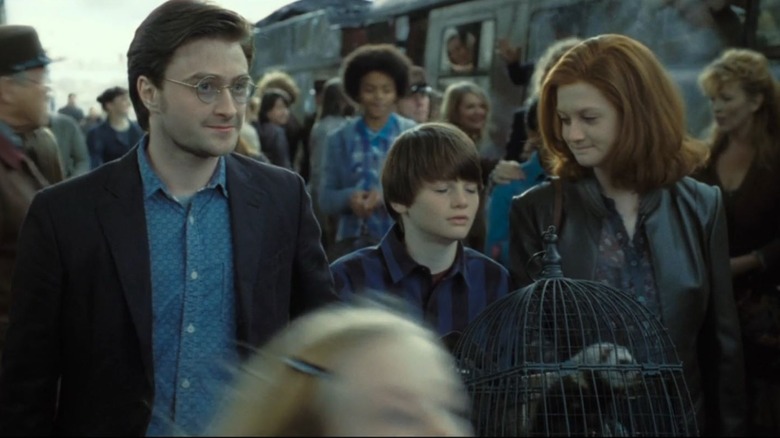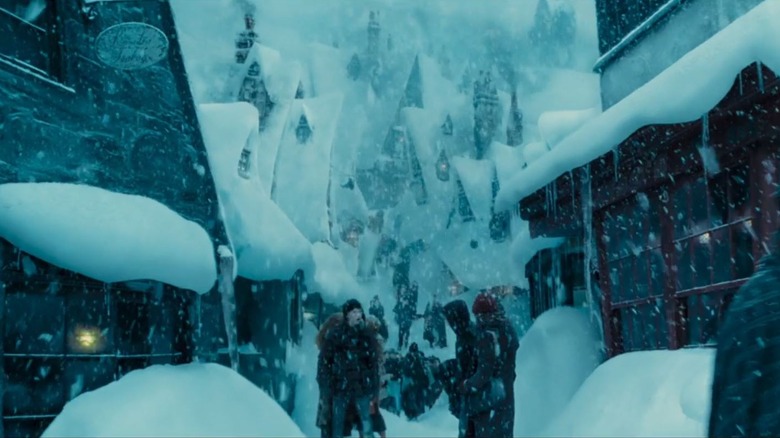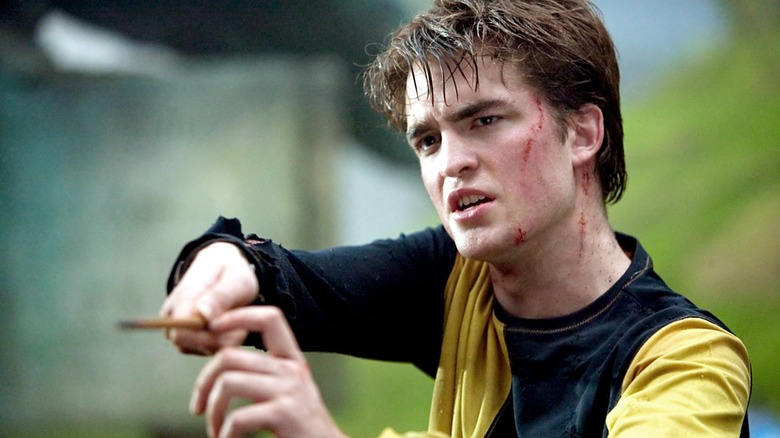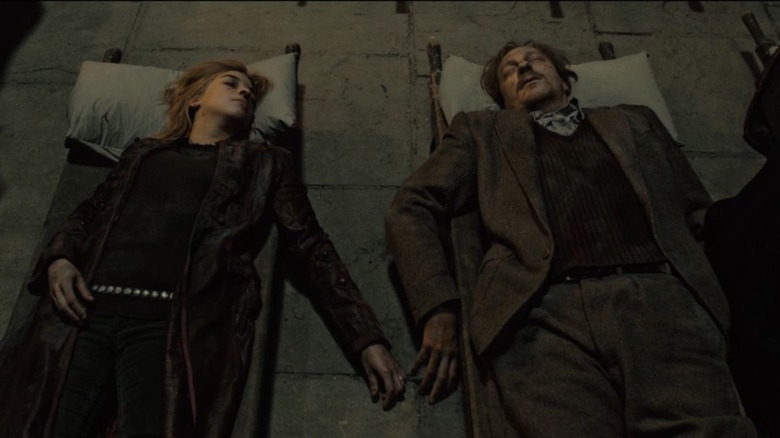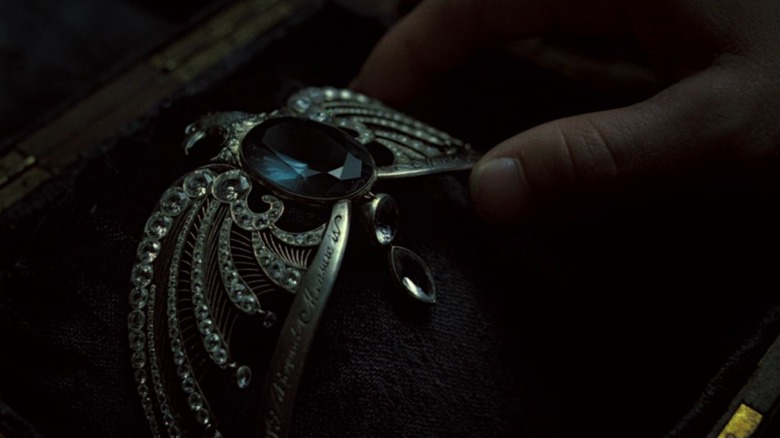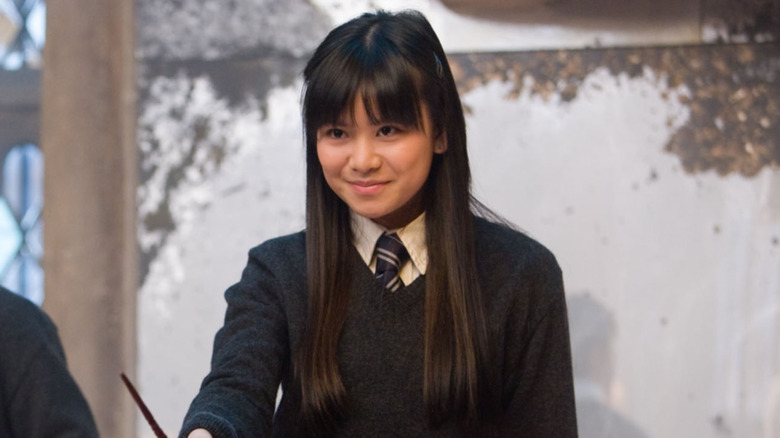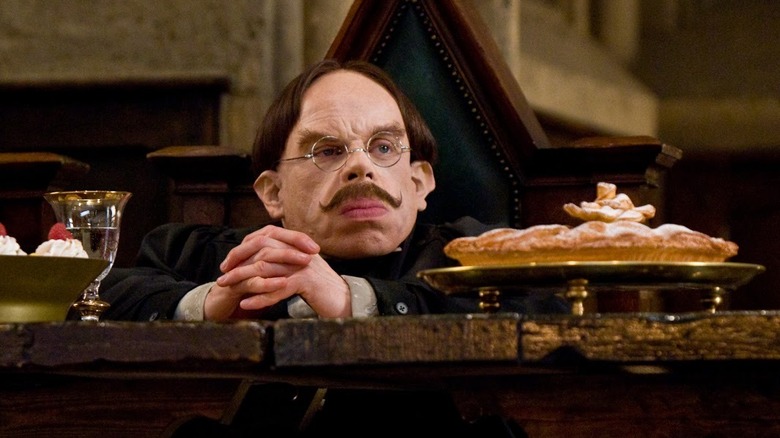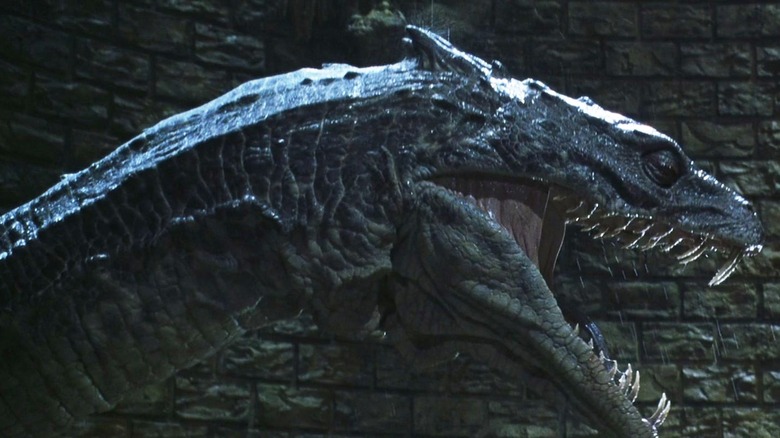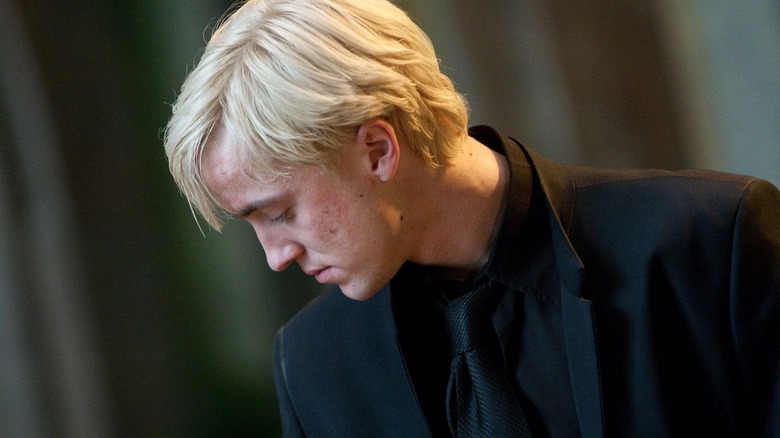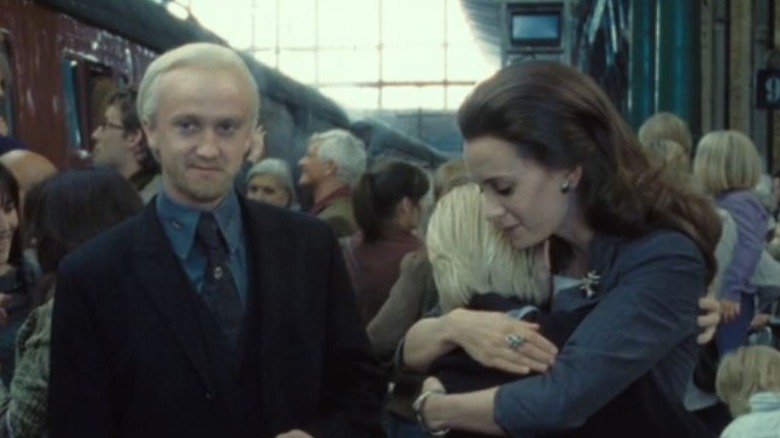The History Of Every Hogwarts House Explained
Ever since J.K. Rowling unleashed her "Harry Potter" books upon the world, fans have spent a great deal of time dreaming of getting their invitation to Hogwarts, Britain's premier source of mystic education, and discovering which of its four houses they would ultimately be sorted into. Each house was created by one of the four founders of the school according to their respective specialties, personalities, and philosophies regarding magic.
Gryffindor wanted his students to have the courage to put their education to good use, while Hufflepuff valued those who were diligent and kind. Ravenclaw believed that the sole purpose of a student at a school should be knowledge and learning, while Slytherin wanted his underlings to be pure-blooded wizards that would never shy from using their cunning to keep the Wizarding World on top.
Newcomers to the institution are divided between the houses by the Sorting Hat in the first major ceremony of each school year, and that placing will determine who they live, study, and work with for the next seven years of their lives. Here's a look at the history of each Hogwarts house.
The Founding of the Hogwarts School of Witchcraft and Wizardry
The Hogwarts School of Witchcraft and Wizardry was founded over 1,000 years ago in Scotland by the four greatest British witches and wizards of the age: Godric Gryffindor, Helga Hufflepuff, Rowena Ravenclaw, and Salazar Slytherin. They spent time weaving a complex system of spells to protect the school, leaving it "unplottable" on any maps in order to forever hide its location. The spells also nullified any attempts to "apparate" or teleport to the castle or its surrounding area.
Though the four worked well together in the beginning, each founder had a different opinion on what aspect of learning students should focus on the most. Instead of clashing over these differing beliefs, the founders chose to organize the school into four houses that would each come to embody its founder's principles.
These houses dominate Hogwarts life. The "House Cup," for example, is awarded at the end of the year to the house with the most points. Students who impress their teachers are rewarded points, while troublemakers cost their house points for every misdeed. Plus, students' dormitories, common rooms, and seating arrangements in the meal hall are organized by house, and each house has a member of the faculty that serves as the "Head of House" in charge of its day-to-day management.
Godric Gryffindor
Born in an English moor now referred to as "Godric's Hollow" in his honor, Godric Gryffindor was one of the greatest wizards and duelists of the early Middle Ages. His mystical silver sword, known by future generations as the "Sword of Gryffindor" was forged by goblins, the wizarding world's most skilled weapon-smiths, and his classical wizard's hat was used by the four founders to create the famed "Sorting Hat" that organizes students into houses.
Godric founded his house on the values of courage: "daring, nerve, and chivalry." The house's emblem is a lion, its colors are scarlet and gold, and its corresponding element is fire. Godric wanted his house to be unafraid to take a stand, for what use is knowledge or learning if those who have it are too afraid or unwilling to fight for what is right? If a student had a certain strength of heart, then the rest would inevitably come as well.
Gryffindor during the series
Gryffindor was easily the most prominent house in the main "Harry Potter" series of books and films, and many of the series' most famous and beloved characters belonged to it. In addition to Harry Potter, Hermione Granger, and Ron Weasley, the series' main trio of heroes, the house could also proudly claim many other popular characters in its ranks, including Albus Dumbledore, Hagrid, Professor McGonagall, Sirius Black, Remus Lupin, and Neville Longbottom.
In part, perhaps due to the house's emphasis on courage, its members are often at the heart of the wizarding world's greatest conflicts. It was Harry, Ron, and Hermione who kept Voldemort from using the Philosopher's Stone to resurrect himself, and it was the same three who discovered and closed the Chamber of Secrets, killing the Basilisk within.
Students of House Gryffindor often emerged as valiant leaders throughout the Second Wizarding War against Voldemort and his Death Eaters. They were the ones who founded "Dumbledore's Army," a secret, underground, student-led organization that practiced combat magic and formed a resistance that opposed the likes of Dolores Umbridge and that fought in the Battle of Hogwarts. It was Neville Longbottom who led the charge while wielding the Sword of Gryffindor, and it was Harry Potter who finally destroyed Voldemort once and for all.
Gryffindor after the series
After the dark wizard was finally beaten, former head of House Gryffindor Minerva McGonagall was appointed the new headmistress of the school, and Neville Longbottom eventually became the herbology professor. The school grounds were repaired and reopened as the school continued business as usual.
Harry Potter, Hermione Granger, Ron Weasley, and many other Gryffindor students all went on to work at the Ministry of Magic, with Harry going on to become head auror while Hermione became the minister of magic, the head of the entire British magical governing body. Ginny Potter née Weasley, meanwhile, went on to become a professional Quidditch player for the Holyhead Harpies and a sports reporter for the Daily Prophet.
Gryffindor was praised and honored for its lengthy, involved role in the defeat of Voldemort and the achievements of its many students, and thus it remains one of the most respected houses at the school. In the latter half of the 2010s, many of the series' main characters began sending their children to the school, and James Potter II, Lily L. Potter, and Rose Granger-Weasley were all sorted into the house.
Helga Hufflepuff
Helga Hufflepuff was a Welsh witch who, when founding her Hogwarts House, decided that what she needed her students to be, above all else, was loyal, hardworking, and kind. She invited students from all different backgrounds, treated them equally, and brought them together to be united by patience and tolerance.
She was famous for her many food-related charms, and she was directly involved in founding the school's feasting hall and kitchens. It was her decision to create a contingent of house elves to work as servants there so that they could be protected from the abuse and prejudice they typically faced elsewhere.
Helga picked yellow and black as her house colors and selected the badger as its animal, for it is "often underestimated, because it lives quietly until attacked, but which, when provoked, can fight off animals much larger than itself, including wolves." The members of this house value friendship and will fight to the bitter end to keep their loved ones safe. Its corresponding element is earth, and one of its original students, Hengist of Woodcroft, founded the wizarding village of Hogsmeade near the Hogwarts Castle grounds.
Hufflepuff during the series
Though many see its willingness to accept everybody as a sign that its students aren't intelligent, brave, or cunning enough to make it into the other houses, it has produced a number of exceptional witches and wizards, including the famous Newt Scamander, the magizoologist, author, and main character of the "Fantastic Beasts" series of films.
During the "Harry Potter" series, Pomona Sprout, the professor of herbology, was Hufflepuff's head of house. Though the house rarely harbored any rivalries, that changed for a time during the fourth book, "Goblet of Fire," when Harry Potter entered the Triwizard Tournament despite the fact that a Hufflepuff named Cedric Diggory had been selected as the school's champion.
Though Cedric ultimately won the Triwizard Tournament, he and Harry were transported to Voldemort when they both took hold of the Triwizard Cup. Voldemort had Cedric killed immediately after his arrival, but his shadow, or echo, was among the many that attacked Voldemort afterwards and helped Harry escape back to Hogwarts with Cedric's body.
Another famous Hufflepuff, Nymphadora Tonks, would prove to be one of the most important members of the Order of the Phoenix and its fight against Voldemort and his Death Eaters. A metamorphmagus who could transform her physical appearance at will, she worked as an auror and fought throughout many of the series' most important battles. Though she married and had a child with Remus Lupin, both of them gave their lives during the Battle of Hogwarts.
Hufflepuff after the series
During the Battle of Hogwarts, Hufflepuff lived up to its symbolic animal, the badger, and was the only house besides Gryffindor to have nearly every single one of its students stand up and fight Voldemort's army. Though they valued peace, tolerance, and kindness, they were more than willing to fight for what was right, especially when threatened on their home turf.
Remus Lupin and Nymphadora Tonks' son, Edward, would be sorted into House Hufflepuff when he turned 11 in 2009 and carry on his mother's legacy as a metamorphmagus as well. Additionally, another Hufflepuff named Hannah Abbott would become the landlady of the Leaky Cauldron, a popular pub for wizards and witches that served as an entrance to Diagon Alley. She would eventually marry Neville Longbottom, and the two would live above the Cauldron for some time, though Hannah would later apply to become Hogwarts' new "matron," the school's primary nurse.
Rowena Ravenclaw
Born in the glens of Scotland, Rowena Ravenclaw was one of the most intelligent and powerful witches of her day. Rowena is believed to have been responsible for Hogwarts' name, its location, and its ever-changing, constantly-shifting floor plan. She is also famous as the creator and bearer of the "Ravenclaw Diadem," a mystic circlet that was said to increase the wisdom and intelligence of whoever used it.
Rowena founded her house on the simple assertion that the primary focus of a Hogwarts student should be education and intelligence. Thus, she selected the students who were the most curious, creative, witty, and clever to join her house, one of whom was Ignatia Wildsmith, the inventor of Floo Powder.
Rowena chose the high-flying eagle as the house animal, symbolizing air, their corresponding element, and blue and bronze as their colors. Additionally she placed Ravenclaw's common room and dormitories in a tower on the west side of the castle grounds, and made sure that its entrance was blocked by a door that would only open for students who could solve its daily riddle.
Unfortunately, Rowena was the first of the four founders to die. After her diadem was stolen by her daughter, Helena, Rowena fell ill and never recovered. Though she tried to find and see her daughter one last time, she died before she could do so.
Ravenclaw during the series
Though Professor Filius Flitwick, who taught charms, was the head of house, Gilderoy Lockhart was the first famous Ravenclaw featured in the "Harry Potter" series. After he graduated Hogwarts, he used memory charms to steal credit for others' achievements, write about them as if they were his own, and pass himself off as a valiant adventurer. He became the school's new Defense Against the Dark Arts teacher during "Chamber of Secrets," but was ultimately outed by Harry and Ron when he tried to flee and accidentally erased his own mind.
The wand-maker Garrick Ollivander and the divination professor Sybill Trelawney were both members of the house during their time at Hogwarts, but Cho Chang and Luna Lovegood would prove to be the most important Ravenclaws during the series. Cho was a member of Dumbledore's Army who fought in the Battle of Hogwarts after her graduation. She briefly dated both Cedric and Harry until her fellow Ravenclaw, Marietta Edgecombe, betrayed the DA by revealing their meeting location in the Room of Requirement.
Luna Lovegood was one of the first people to believe Harry when he announced Voldemort's return, and she became one of his most important allies at the school. When Voldemort's Death Eaters controlled Hogwarts during "The Deathly Hallows," Luna helped reform Dumbledore's Army and led a resistance until she was captured and held in the basement of Malfoy Manor, though she was freed with plenty of time to fight during the final battle.
Ravenclaw after the series
After Voldemort's defeat, Luna Lovegood went on to become a famous wizarding naturalist and met and married Rold Scamander, the grandson of the author of "Fantastic Beasts and Where to Find Them." She found and documented many previously undiscovered magical creatures, but eventually had to accept that the "Crumple-Horned Snorkack" that her father told her about as a child actually was just a fairy tale.
Gilderoy Lockhart would remain a permanent resident at St Mungo's Hospital for Magical Maladies and Injuries due to the extreme damage he did to his mind, and many Ravenclaws, including Professors Flitwick and Trelawney, would provide invaluable help during "the Calamity," a mystic event during which a number of objects, people, creatures, and concepts were sent asunder through both time and space, threatening to forever break the statute of secrecy that protected the wizarding world from being discovered by the rest of the planet.
Salazar Slytherin
Salazar Slytherin was raised in a pure-blood Irish family and was born with the rare magical ability to speak "Parseltongue," the language of snakes. A profoundly gifted wizard, he is said to have created his own wand out of snakewood using a basilisk horn for its core. When he joined his childhood friend Godric Gryffindor to help create Hogwarts, he founded his house on the values of ambition, leadership, and cunning.
He wanted students who were resourceful and shrewd, and though he worked well with the other founders for a time, he was ultimately responsible for establishing several legacies that would haunt Hogwarts. It was his desire to exclude Muggle-born students from Hogwarts that eventually forced him to leave, ended his friendship with Godric, and created the rivalry between Slytherin and Gryffindor that lasts to the present day.
Additionally, he built the Chamber of Secrets and placed the basilisk within it that first Tom Riddle and then a bewitched Ginny Weasley unleashed upon the school's unsuspecting students. He specifically created this chamber so that his heirs could later open it and let the monster inside drive out "impure" students. With a founder like this, it's pretty easy to see why Slytherin developed a sinister reputation.
Slytherin during the series
Slytherin was one of the most important houses during the "Harry Potter" series. Severus Snape, its head of house, simultaneously served as a professor at Hogwarts and as Dumbledore's secret spy within Voldemort's army — which proved to be one of the only reasons that the dark lord was ultimately defeated. Many of Slytherin's students and graduates joined the ranks of Voldemort's Death Eaters, and the evil wizard himself was a member of the house when he still went by the name "Tom Riddle."
It was mainly Slytherins who joined Dolores Umbridge's "Inquisitorial Squad" and spied on other students, docking points and reporting anybody who disagreed with or resisted the evil woman's new rules. Similarly, it was Draco Malfoy, the most famous member of the house, who managed to sneak several Death Eaters into Hogwarts during "The Half-Blood Prince" and disarm Dumbledore so Snape could kill the headmaster and cement his cover as a loyal servant of Voldemort.
Ultimately, during the Battle of Hogwarts, most remaining Slytherins chose to evacuate instead of fight, and those who sided with the dark lord were largely imprisoned for their crimes, though some, like the Malfoy family, avoided this fate by switching sides during the final hours of the Second Wizarding War.
Slytherin after the series
Of all the houses, Slytherin had the most turbulent journey to take after the Battle of Hogwarts. The house was hated for a number of years for the role it had played in the Second Wizarding War, but it would eventually emerge the better for it.
After the battle, many Slytherins, including Draco Malfoy and his future wife, Astoria Greengrass, would come to see the inherent bigotry in their former pure-blood supremacist views and reject them. In fact, by 2017, the house as a whole was no longer the "pure-blood bastion" that it had been during Harry Potter's time at Hogwarts.
This can be seen by the character of both Harry and Draco's children. Malfoy and Astoria took great care to raise their son Scorpius to be far kinder and more accepting than his father had ever been at his age, and it was this kindness that helped him become best friends with Harry and Ginny's son Albus Severus Potter. The pair were a stark contrast to their fathers, and their dual acceptance into House Slytherin shows just how far the house had come in the decades since the war.
During "Harry Potter and the Cursed Child," Albus and Scorpius were manipulated into accidentally altering history with a time turner as a part of a complicated scheme to stop Voldemort's defeat using time travel. Fortunately, Harry, Ron, Ginny, and Draco traveled back in time to save them and defeat Delphi, the mastermind behind the plot.
